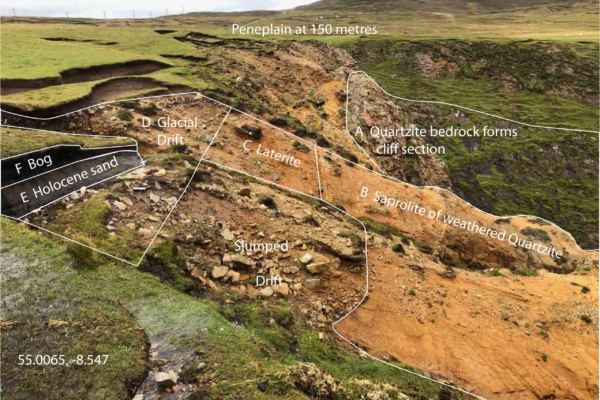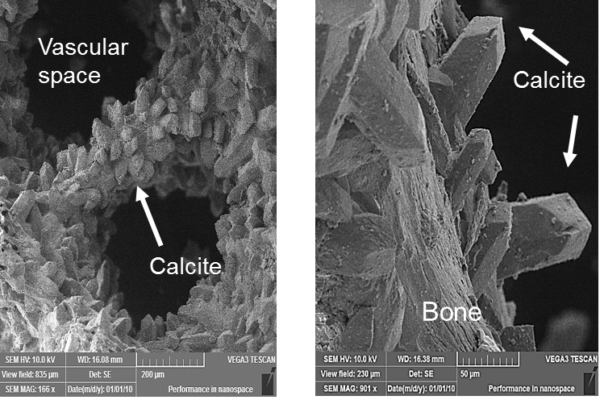
1911 Encyclopædia Britannica/Limonite
LIMONITE, or Brown Iron Ore, a natural ferric hydrate named from the Gr. λειμών (meadow), in allusion to its occurrence as “bog-ore” in meadows and marshes. It is never crystallized, but may have a fibrous or microcrystalline structure, and commonly occurs in concretionary forms or in compact and earthy masses; sometimes mammillated (covered with rounded mounds or lump, nipples or small protuberances), botryoidal (having a shape reminiscent of a cluster of grapes), reniform (kidney-shaped) or stalactitic (icicle-shaped). The colour presents various shades of brown and yellow, and the streak is always brownish, a character which distinguishes it from haematite with a red, or from magnetite with a black streak. It is sometimes called brown haematite.
Limonite is a ferric hydrate, conforming typically with the formula Fe4O3(OH)6, or 2Fe2O3·3H2O. Its hardness is rather above 5, and its specific gravity varies from 3.5 to 4. In many cases it has been formed from other iron oxides, like haematite and magnetite, or by the alteration of pyrites or chalybite.
By the operation of meteoric agencies, iron pyrites readily pass into limonite often with retention of external form; and the masses of “gozzan” or “gossan” on the outcrop of certain mineral-veins consist of rusty iron ore formed in this way, and associated with cellular quartz. Many deposits of limonite have been found, on being worked, to pass downwards into ferrous carbonate; and crystals of chalybite converted superficially into limonite are well known. Minerals, like glauconite, which contain ferrous silicate, may in like manner yield limonite, on weathering. The ferric hydrate is also readily deposited from ferruginous waters, often by means of organic agencies. Deposits of brown iron ore of great economic value occur in many sedimentary rocks, such as the Lias, Oolites and Lower Greensand of various parts of England. They appear in some cases to be altered limestones and in others altered glauconitic sandstones. An oolitic structure is sometimes present, and the ores are generally phosphatic, and may contain perhaps 30% of iron. The oolitic brown ores of Lorraine and Luxemburg are known as “minette,” a diminutive of the French mine (ore), in allusion to their low content of metal. Granular and concretionary limonite accumulates by organic action on the floor of certain lakes in Sweden, forming the curious “lake ore.” Larger concretions formed under other conditions are known as “bean ore.” Limonite often forms a cementing medium in ferruginous sands and gravels, forming “pan”; and in like manner it is the agglutinating agent in many conglomerates, like the South African “banket,” where it is auriferous. In iron-shot sands the limonite may form hollow concretions, known in some cases as “boxes.” The “eagle stones” of older writers were generally concretions of this kind, containing some substance, like sand, which rattled when the hollow nodule was shaken. Bog iron ore is an impure limonite, usually formed by the influence of micro-organisms, and containing silica, phosphoric acid and organic matter, sometimes with manganese. The various kinds of brown and yellow ochre are mixtures of limonite with clay and other impurities; whilst in umber much manganese oxide is present. Argillaceous brown iron ore is often known in Germany as Thoneisenstein; but the corresponding term in English (clay iron stone) is applied to nodular forms of impure chalybite. J. C. Ullmann’s name of stilpnosiderite, from the Greek στιλπνός (shining) is sometimes applied to such kinds of limonite as have a pitchy lustre. Deposits of limonite in cavities may have a rounded surface or even a stalactitic form, and may present a brilliant lustre, of blackish colour, forming what is called in Germany Glaskopf (glass head). It often happens that analyses of brown iron ores reveal a larger proportion of water than required by the typical formula of limonite, and hence new species have been recognized. Thus the yellowish brown ore called by E. Schmidt xanthosiderite, from ζξανθός (yellow) and σίδηρος (iron), contains Fe2O(OH)4, or Fe2O3·2H2O; whilst the bog ore known as limnite, from λίμνη (marsh) has the formula Fe(OH)3, or Fe2O3·3H2O. On the other hand there are certain forms of ferric hydrate containing less water than limonite and approaching to haematite in their red colour and streak: such is the mineral which was called hydrohaematite by A. Breithaupt, and is now generally known under R. Hermann’s name of turgite, from the mines of Turginsk, near Bogoslovsk in the Ural Mountains. This has the formula Fe4O5(OH)2, or 2Fe2O3·H2O. It probably represents the partial dehydration of limonite, and by further loss of water may pass into haematite or red iron ore. When limonite is dehydrated and deoxidized in the presence of carbonic acid, it may give rise to chalybite.
1911 Encyclopædia Britannica/Limonite




